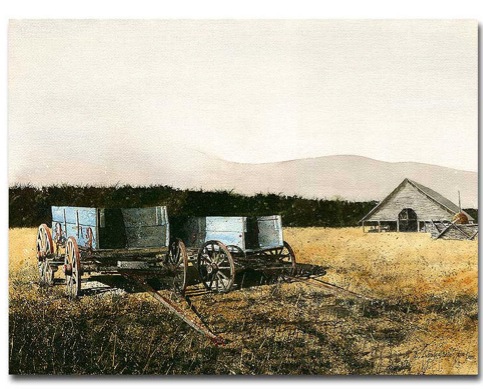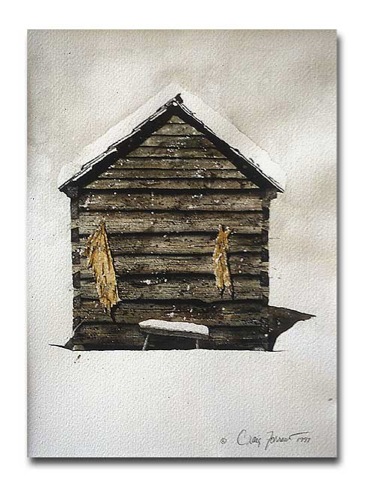Great Smoky Mountains National Park
As I have stated
elsewhere on the site, the North Carolina entrance to
the Great Smoky Mountains National Park is near the
northwestern border of Jackson County. I have done
paintings of several subjects located in the park.
Click on images below to see a larger version.
Click on images below to see a larger version.
Tom Massie on Little River,
watercolor
This is a painting of my friend Tom Massie fly fishing for mountain trout. The painting was commissioned by Tom's wife and she didn't want him to know that I was going to paint it. It was drizzling rain and the fish weren't biting so I told Tom that if he didn't mind I would like to take some pictures. Finally Tom had put up with me enough and hollered out, "Did you come to take pictures or fish?" I put the camera away and picked up my fly rod hoping I had a good image or two to work with.
In our southern mountain trout streams you have to stalk the trout. They are very easily put down by quick movement and especially bright clothing. Tom is wearing camouflage and at first glance, a lot of viewers fail to even notice him in the composition.
This is a painting of my friend Tom Massie fly fishing for mountain trout. The painting was commissioned by Tom's wife and she didn't want him to know that I was going to paint it. It was drizzling rain and the fish weren't biting so I told Tom that if he didn't mind I would like to take some pictures. Finally Tom had put up with me enough and hollered out, "Did you come to take pictures or fish?" I put the camera away and picked up my fly rod hoping I had a good image or two to work with.
In our southern mountain trout streams you have to stalk the trout. They are very easily put down by quick movement and especially bright clothing. Tom is wearing camouflage and at first glance, a lot of viewers fail to even notice him in the composition.
Haystack, watercolor
This haystack is located at the mountain farm museum near the Oconaluftee ranger station on the Cherokee side of the park. It is built by the park staff every year much as it would have been years ago by the pioneers who settled the park. A locust pole fence surrounds the hay to keep the livestock away. This is a late summer scene, a very hot afternoon. However, on a summer evening in the park you'll probably find yourself reaching for a sweater.
This haystack is located at the mountain farm museum near the Oconaluftee ranger station on the Cherokee side of the park. It is built by the park staff every year much as it would have been years ago by the pioneers who settled the park. A locust pole fence surrounds the hay to keep the livestock away. This is a late summer scene, a very hot afternoon. However, on a summer evening in the park you'll probably find yourself reaching for a sweater.
Homespun, watercolor
This fabric was hanging in a window of the John E. Davis cabin at the mountain farm museum.
According to a pamphlet from the park service: "Davis constructed the house with 'matched' chestnut logs. A log was hewed flat on two sides, then split in half along its length to produce two building logs. These were used in 'matching' positions on opposite walls. The ends of the logs were joined with half-dovetailed notches.
The half-dovetail joint took more time to prepare than some other notches, but it 'locked' the logs together and the downward sloping surfaces of the notch shed rainwater away from the structure. Unlike many log houses, Davis chose to seal the chink, or crack, between the logs with hand-split boards instead of clay. More than 50 years later Davis recalled, 'when it was finished I had myself a pretty fine place'."
This fabric was hanging in a window of the John E. Davis cabin at the mountain farm museum.
According to a pamphlet from the park service: "Davis constructed the house with 'matched' chestnut logs. A log was hewed flat on two sides, then split in half along its length to produce two building logs. These were used in 'matching' positions on opposite walls. The ends of the logs were joined with half-dovetailed notches.
The half-dovetail joint took more time to prepare than some other notches, but it 'locked' the logs together and the downward sloping surfaces of the notch shed rainwater away from the structure. Unlike many log houses, Davis chose to seal the chink, or crack, between the logs with hand-split boards instead of clay. More than 50 years later Davis recalled, 'when it was finished I had myself a pretty fine place'."
Late Afternoon, watercolor
Two wagons in the field in front of the barn at the Mountain Farm Museum.
According to the park's pamphlet:
"No single building better symbolizes a farm now or in the past than a barn. It was a stable for livestock and the loft above stored much of the feed that would sustain the animals through the winter. Barns often provided a sheltered place for various endeavors ranging from woodworking to equipment repair. It was also where many farm tools, from hoes and harrows to plows and wagons, could be found when not in use."
This is a late summer scene, late in the day with some mist moving across the mountains in the background.
Two wagons in the field in front of the barn at the Mountain Farm Museum.
According to the park's pamphlet:
"No single building better symbolizes a farm now or in the past than a barn. It was a stable for livestock and the loft above stored much of the feed that would sustain the animals through the winter. Barns often provided a sheltered place for various endeavors ranging from woodworking to equipment repair. It was also where many farm tools, from hoes and harrows to plows and wagons, could be found when not in use."
This is a late summer scene, late in the day with some mist moving across the mountains in the background.
Out to Dry, watercolor
This meat house was moved to the Mountain Farm Museum from the Cataloochee area of the park.
The painting gets its title from the animal skins nailed to the rear wall.
This building was close to the cabin for security reasons as it contained the families meat supply for the winter. Pork was the primary meat as it could be fairly easily preserved through curing with salt and pepper and smoking. Smoking produced chemical compounds that warded off insects and bacteria.
This meat house was moved to the Mountain Farm Museum from the Cataloochee area of the park.
The painting gets its title from the animal skins nailed to the rear wall.
This building was close to the cabin for security reasons as it contained the families meat supply for the winter. Pork was the primary meat as it could be fairly easily preserved through curing with salt and pepper and smoking. Smoking produced chemical compounds that warded off insects and bacteria.
Crib Raiders, watercolor
Early pioneers in the Great Smoky Mountains had to guard against deer stealing corn from their corn cribs in the long, cold winters.
The deer soon learned to poke their sharp hooves into the chinking of the log cribs, creating openings from which the stored corn could flow out.
According to the Great Smoky Mountains Natural History Association: "The corn crib represents the greatest Indian legacy to the pioneer. Of all the farmstead crops, Indian maize was far and away the most essential. Corn, in addition to keeping the livestock alive, was by far the chief item - the staple - of the pioneer's diet. Besides roastin' ears and the ever present corn meal that made hoe cakes, corn bread, and meal mush, corn was frequently converted into a liquid which came to be known as moonshine".
But that's another story.......
Early pioneers in the Great Smoky Mountains had to guard against deer stealing corn from their corn cribs in the long, cold winters.
The deer soon learned to poke their sharp hooves into the chinking of the log cribs, creating openings from which the stored corn could flow out.
According to the Great Smoky Mountains Natural History Association: "The corn crib represents the greatest Indian legacy to the pioneer. Of all the farmstead crops, Indian maize was far and away the most essential. Corn, in addition to keeping the livestock alive, was by far the chief item - the staple - of the pioneer's diet. Besides roastin' ears and the ever present corn meal that made hoe cakes, corn bread, and meal mush, corn was frequently converted into a liquid which came to be known as moonshine".
But that's another story.......
Smoky Mountain Spruce,
watercolor
These spruce trees grow near Newfound Gap at the crest of the Smokies. I made a trip in my Jeep with my friend Larry Tucker just after a deep snow had fallen.
Larry is an excellent photographer and we had a fine day of making photographs of some of the most beautiful snow scenes I've witnessed since living in the western NC mountains.
These spruce trees grow near Newfound Gap at the crest of the Smokies. I made a trip in my Jeep with my friend Larry Tucker just after a deep snow had fallen.
Larry is an excellent photographer and we had a fine day of making photographs of some of the most beautiful snow scenes I've witnessed since living in the western NC mountains.








